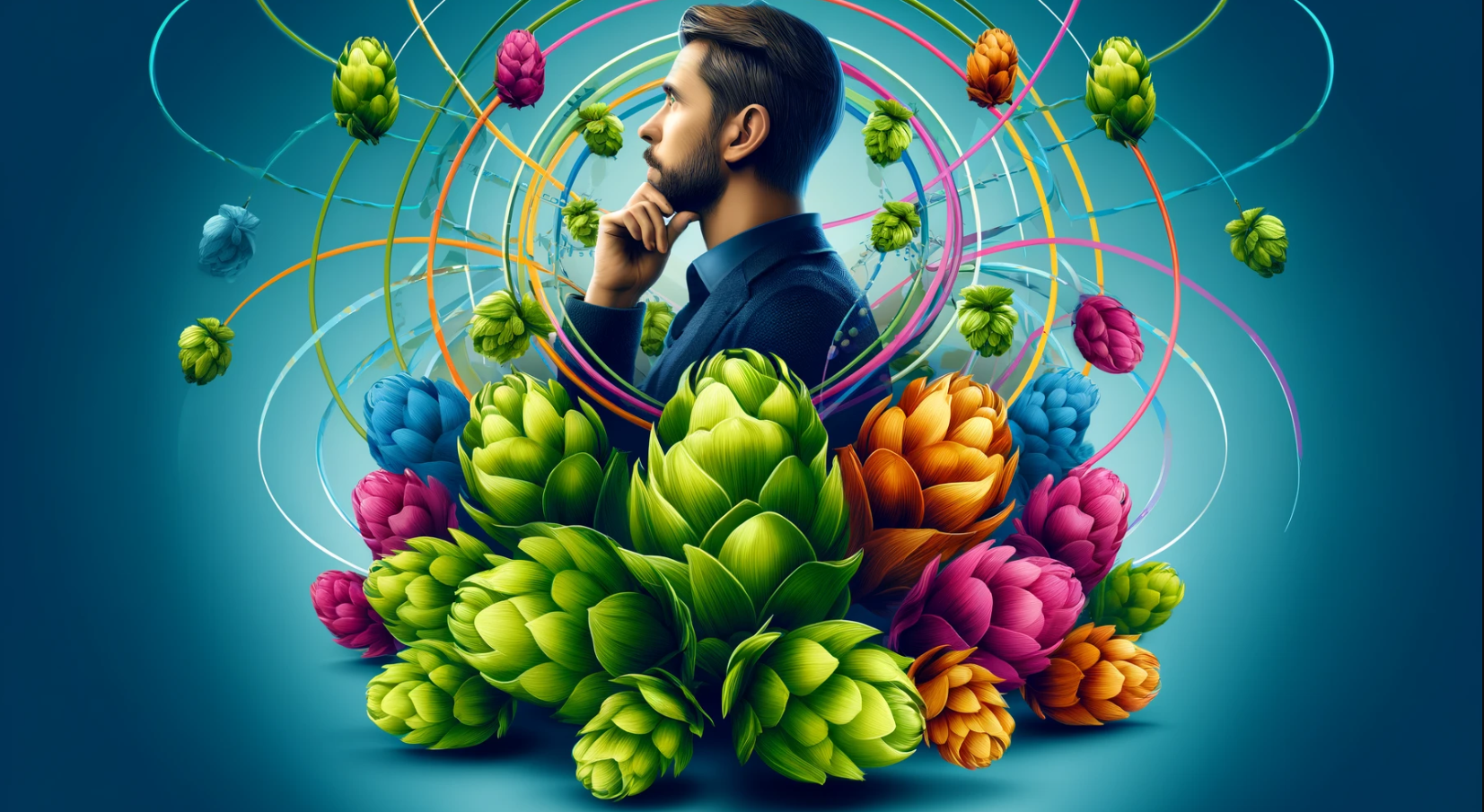When it comes to brewing, everything can go wrong, and each detail counts. Each ingredient can make a difference for homebrewers. In this article, we’ll focus on hops: how to choose them and how to make the most of them.
Hops are a vine belonging to the Cannabaceae family, whose green cones, produced by female plants, are used to brew beer. Beer is composed of four essential ingredients: malt, water, yeast, and hops. Although its use is often associated with the IPA type of beer, hops play an important role in all styles.
The selection of this ingredient is therefore crucial, as it will have a direct impact on the taste and aroma of the beer produced. Today, there are over a hundred different hop varieties, each with its own signature aroma and flavor. With so many to choose from, it’s easy to get lost. In a nutshell, here are a few tips to help you choose the right hops.

How to master hop selection for a perfect beer
Before making a choice, it’s important to understand the 3 roles hops play in beer production.
- Preserving beer: Thanks to its antiseptic properties, hops inhibit the growth of certain harmful microorganisms such as lactobacilli, helping to preserve beer by extending its shelf life.
- Bittering: Bittering hops are generally added at the beginning of the boiling phase, for 60 minutes. In a process called isomerization, the alpha acids in the hops are transformed into iso-alpha acids. Unlike alpha acids, these molecules are soluble in the wort and have a very bitter taste. The addition of bitterness balances the sweet, malty flavors provided by the cereals. The bitterness contained in a beer is measured in IBU (International Bitterness Unit).
- Flavoring: The essential oils contained in hops are responsible for most of beer’s hoppy flavors and aromas. There are over 400 different aromatic compounds, which can express a multitude of flavors depending on their concentration and combination. For example, Cascade hops are known for their citrus aromas, while Saaz hops offer more floral and spicy aromas.

Experimenting and conserving hops
Now that we’ve covered the main characteristics of hops, here are the steps to help you choose the right hops for your brew.
1. Bitter or aromatic?
Hops are generally classified into 2 distinct categories: bittering hops and aromatic hops.
Bittering hops are those selected for their high alpha acid concentration. The more alpha acids a hop contains, the higher its bittering power. For example, if a recipe calls for 20g of 5% AA hops, only 10g of a 10% AA hop should be added to achieve the same level of bitterness.
Among the best-known bittering hops are Magnum (12-14% AA), Warrior (15-18% AA), Herkules (12-17% AA), Bravo (14-17% AA), Nugget(11-14% AA) and Columbus (14-17% AA). Generally speaking, bittering hops are less expensive than aromatic varieties. All hops can be used to add bitterness, but the quantity to be used must be adjusted to obtain the desired level of bitterness.
However, not all bittering hops are created equal. Varieties with a high cohumulone ratio, such as Chinook, are often associated with a raspier and sometimes unpleasant bitterness, compared with noble European hops that contain little. Cohumulone is one of the 5 molecules that make up alpha acids.
Hops in the “aromatic” category are selected for their pleasant taste and aroma. Some hops bring citrus and tropical fruit notes, such as grapefruit and mango, while others offer floral, spicy, or resinous aromas. It’s the essential oils that define the hop’s aromatic profile. Aroma perception will vary according to the concentration and interaction of the various aromatic compounds.
Combining different hops in the same brew can create new aromas and increase their aromatic power. To preserve these extremely delicate essential oils, aromatic hops are added to the wort at the end of the boil, during the whirlpool, or in a process known as dry hopping. Some of the most popular aromatic hops are Citra, Mosaic, Cascade, Saaz, Fuggle, and Hallertau Mittlefrüh.
Sometimes, certain hops are classified in a third category called “dual-purpose”, because in addition to having a high percentage of alpha acids, these hops also contain many essential oils with enchanting aromas.

2. Beer style compatibility
Choosing the right hops will largely be guided by the style of beer you wish to brew. Each style is defined by precise parameters established by the BJCP (Beer Judge Certification Program). So, for a Czech-inspired Pilsner, the herbaceous, spicy aromas of Saaz are an excellent choice, while using an American hop with fruity notes doesn’t fit the style.
Analyzing the dominant flavors of the style or recipe will guide you on the type of hops to choose. For example, if you’re using darker malts that bring notes of coffee and chocolate, you might opt for hops with earthy or resinous aromas to complement these flavors.
3. Research and experiment:
Learn about the specific characteristics of the hop varieties you’re considering. Consult online resources, and books or talk to brewing groups for information on aroma profiles, alpha acid levels, and other brewers’ experience with these hops. After all, tastes are personal too. Take notes on your successes as well as your failures, so that you can constantly improve your recipes and expertise.
4. Freshness and storage
Hops are a fragile ingredient that can degrade rapidly if not stored under the right conditions. The two greatest enemies of hops are oxygen and heat.
When exposed to oxygen over an extended period, the hop aroma dissipates and degrades, then changes color to a brownish-yellow hue. This is called oxidation, and it’s accompanied by an odor reminiscent of old cheese. Note, however, that not all varieties have the same color, and some, mainly those from the southern hemisphere, have a natural yellowish tinge.
As for the role of heat, the hotter it is, the more the aging process will be accelerated. If you notice that a hop is showing several signs of oxidation, it’s advisable to avoid using it, at the risk of spoiling your entire brew.
To conclude
Being able to choose your hops wisely is essential to creating a beer recipe with a desired flavor profile. By understanding the characteristics of hops and taking into account the style of beer you wish to brew, the desired level of bitterness, and the desired aromatic balance, and by doing thorough research, you will be able to select the hops that best match your recipe and preferences. All these explanations may seem complex to a neophyte, but I assure you, these upstream efforts will make all the difference between a good beer and an excellent one.

Matthieu Fréchette is the owner of Hoppy.ca, a business dedicated to the sale of brewing ingredients and instruments. Previously, he was a brewer at Le Bilboquet from 2013 to 2017.
Aussi sur le brassage
A History of Kveik
Kveik is an amazing, all-purpose yeast originating from Scandinavia. In recent years, Kveik has generated a lot of excitement and awakened thirst in North America. But what exactly is it? Columnist and speaker Martin Thibault unravels the history of this fabulous yeast over a beer.
What gives Mexican Lagers that signature flavor?
There is something quite unique about the taste of a Mexican Lager. Widely popular in the U.S., the styles whose its signature taste to a hefty dose of corn. Let’s take a deep dive into this famous beer style.
What is the strongest beer in Canada?
What is the strongest beer available in Canada? For those who can stomach the fire, we have listed for you the strongest beers available in the country of the Maple Leaf. The strongest beer in Canada, as of January 2023, was 25 Édition by Brasseurs du Monde, weighing in at 25% ABV (alcohol per volume).…












Leave a Reply